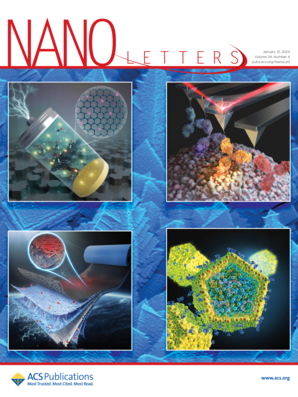电场和曲率效应在金纳米结构中的间隙增强催化作用
IF 9.6
1区 材料科学
Q1 CHEMISTRY, MULTIDISCIPLINARY
引用次数: 0
摘要
等离子纳米结构的催化性能深受表面形态的影响。虽然尖端区域的天线效应受到了广泛关注,但间隙形态的作用却在很大程度上被忽视了。由于形态异质性和成像分辨率的限制,在亚微粒层面理解形态调控催化作用仍然受到制约,从而阻碍了合理的纳米催化剂设计。在这里,我们通过将单分子荧光(SMF)成像与等离子体增强荧光相结合,开发了一种单颗粒催化活性检测方法,从而能够探测等离子体金纳米结构的催化动态及其与局部电场的相关性。利用这种方法,我们证明了金纳米结构上纳米级间隙形成的纳米脊线能显著增强催化活性。利用 SMF 成像、电场模拟和分子动力学模拟进行的进一步研究表明,间隙增强的催化活性是由放大的电场和负弯曲位点上增加的基质吸附所驱动的。这项研究为通过表面形态工程设计等离子纳米催化剂提供了宝贵的见解。本文章由计算机程序翻译,如有差异,请以英文原文为准。

Gap-Enhanced Catalysis in Gold Nanostructures by Electric Field and Curvature Effects
The catalytic performance of plasmonic nanostructures is strongly influenced by surface morphology. While the antenna effect in tip regions has received considerable attention, the role of gap morphology has been largely overlooked. Comprehending morphology-regulated catalysis at the subparticle level remains constrained by morphology heterogeneity and imaging resolution limitations, hindering rational nanocatalyst design. Here, we develop a single-particle catalytic activity assay by coupling single-molecule fluorescence (SMF) imaging with plasmon-enhanced fluorescence, enabling the probing of catalytic dynamics of plasmonic Au nanostructures and their correlation with local electric fields. Using this approach, we demonstrate that nanospine formation with nanoscale gaps on Au nanostructures significantly enhances catalytic activity. Further investigations using SMF imaging, electric field simulations, and molecular dynamics simulations reveal that the gap-enhanced catalytic activity is driven by amplified electric fields and increased substrate adsorption at negatively curved sites. This study provides valuable insights into designing plasmonic nanocatalysts through surface morphology engineering.
求助全文
通过发布文献求助,成功后即可免费获取论文全文。
去求助
来源期刊

Nano Letters
工程技术-材料科学:综合
CiteScore
16.80
自引率
2.80%
发文量
1182
审稿时长
1.4 months
期刊介绍:
Nano Letters serves as a dynamic platform for promptly disseminating original results in fundamental, applied, and emerging research across all facets of nanoscience and nanotechnology. A pivotal criterion for inclusion within Nano Letters is the convergence of at least two different areas or disciplines, ensuring a rich interdisciplinary scope. The journal is dedicated to fostering exploration in diverse areas, including:
- Experimental and theoretical findings on physical, chemical, and biological phenomena at the nanoscale
- Synthesis, characterization, and processing of organic, inorganic, polymer, and hybrid nanomaterials through physical, chemical, and biological methodologies
- Modeling and simulation of synthetic, assembly, and interaction processes
- Realization of integrated nanostructures and nano-engineered devices exhibiting advanced performance
- Applications of nanoscale materials in living and environmental systems
Nano Letters is committed to advancing and showcasing groundbreaking research that intersects various domains, fostering innovation and collaboration in the ever-evolving field of nanoscience and nanotechnology.
 求助内容:
求助内容: 应助结果提醒方式:
应助结果提醒方式:


